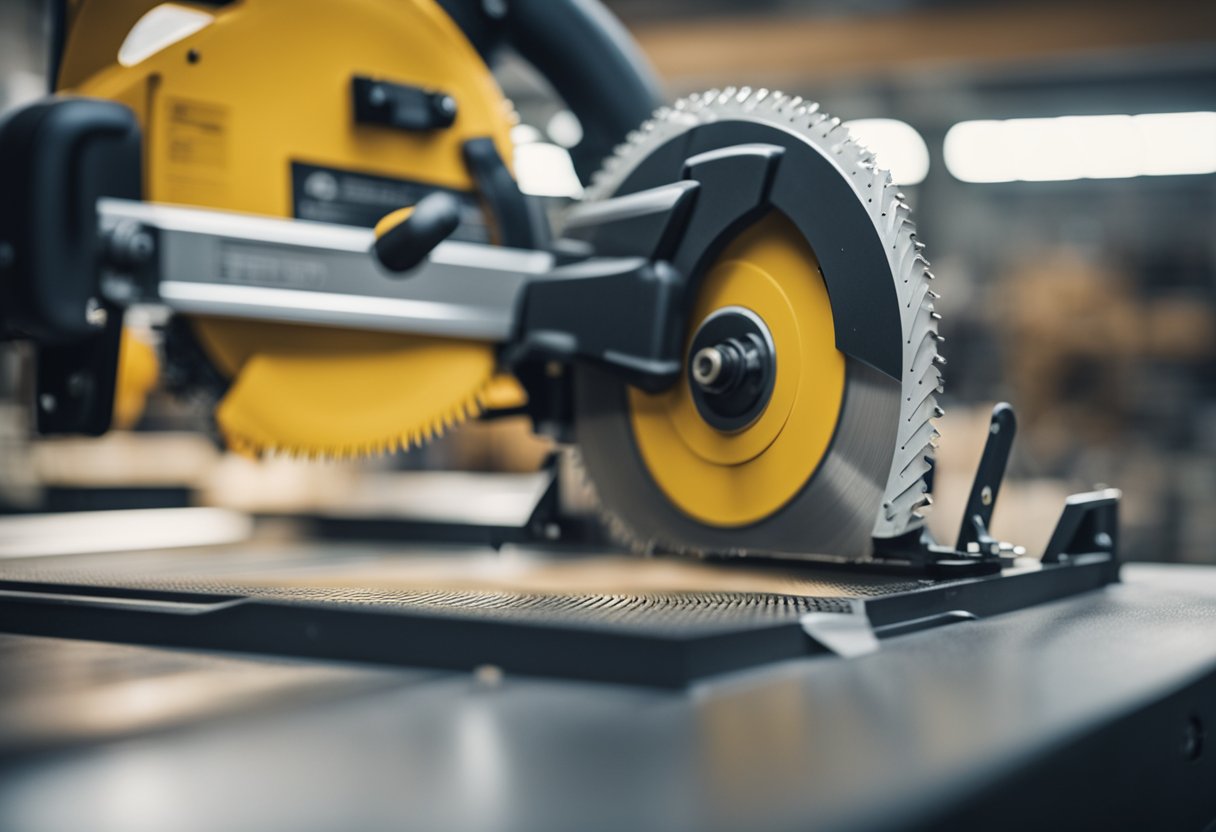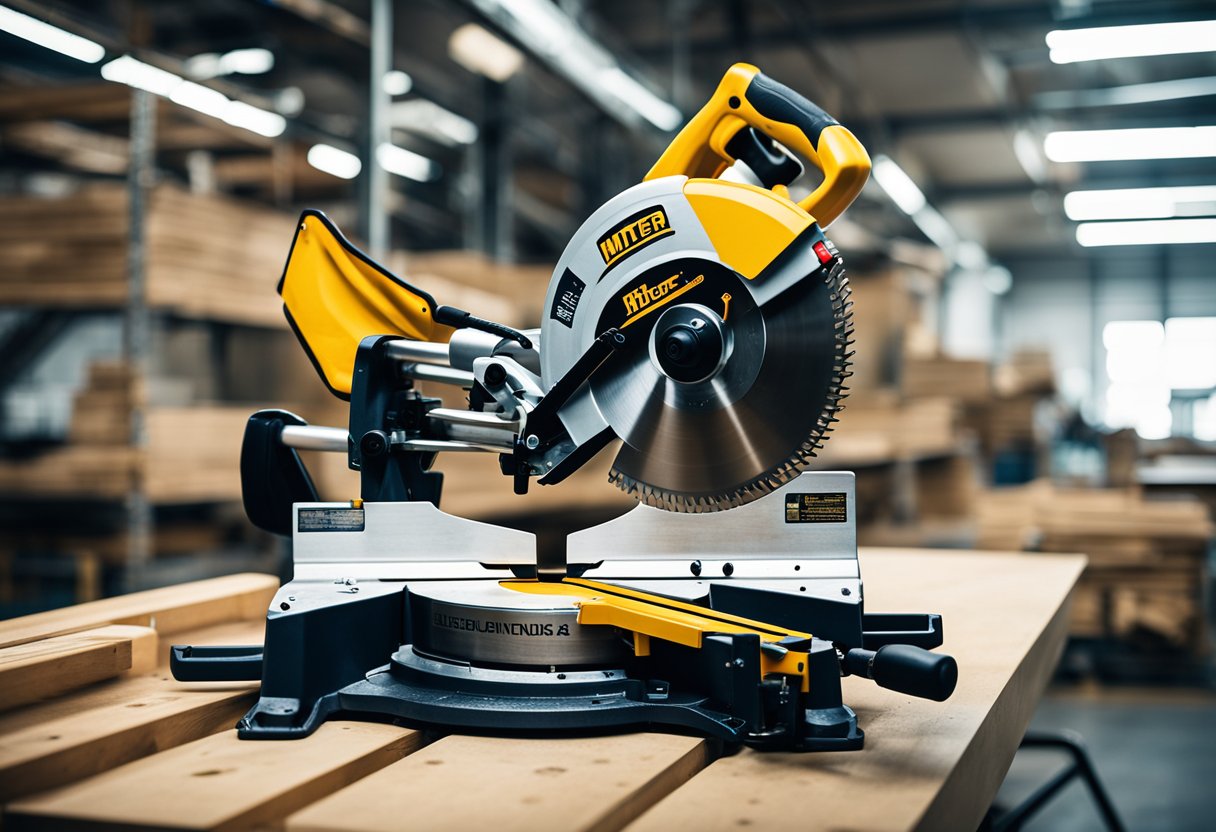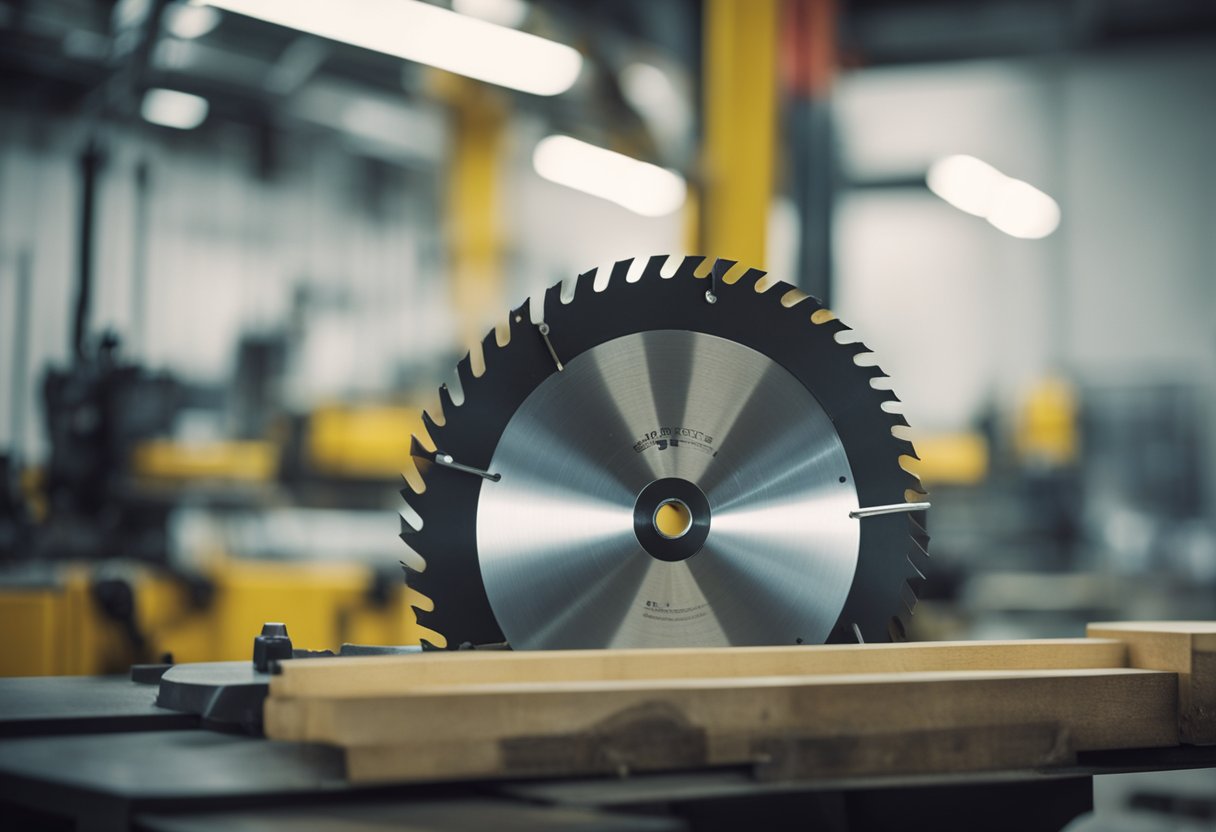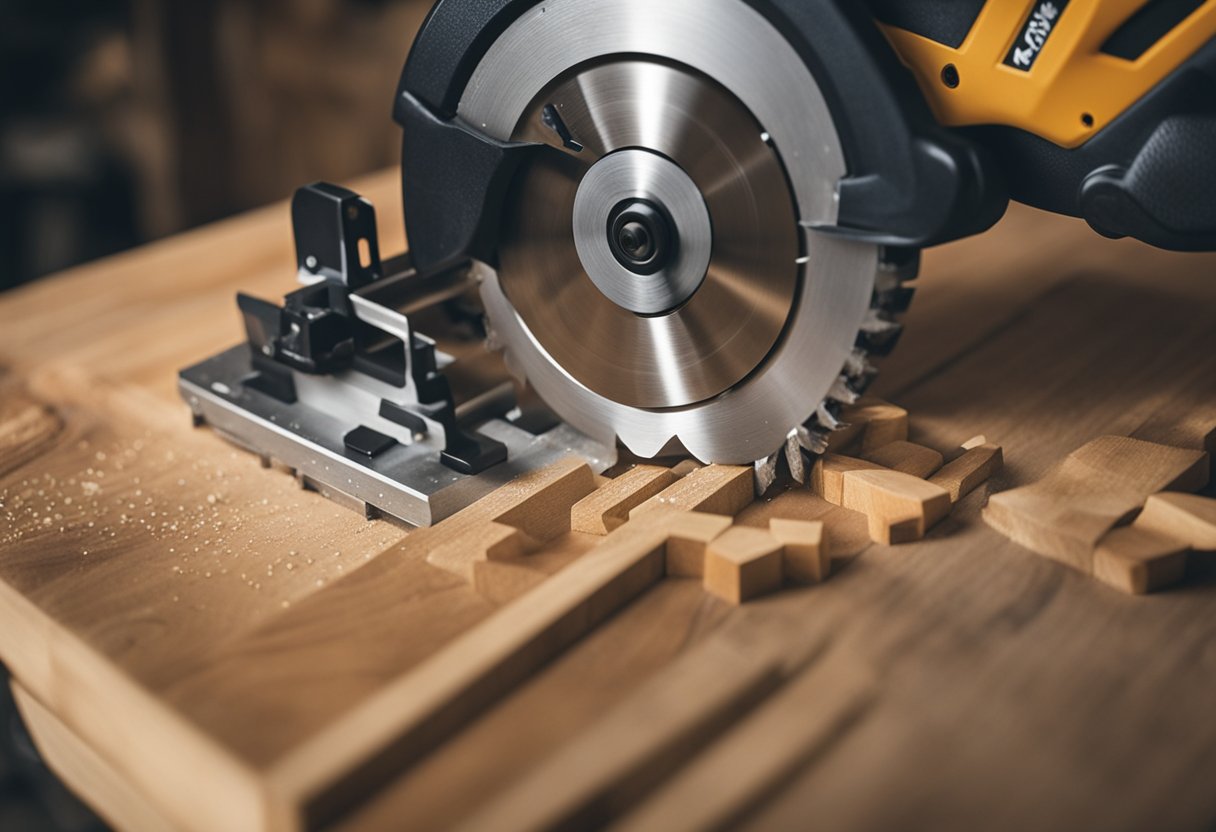Miter saws are an essential tool for any woodworker. They are versatile and can make precise cuts, but problems can arise when the blade starts to wobble. A wobbly blade can make it difficult to make accurate cuts and can even pose a safety hazard. In this article, I will discuss the causes of miter saw blade wobble and how to troubleshoot and fix the problem.
Identifying Miter Saw Blade Wobble is the first step in solving the problem. A blade that wobbles will not make a straight cut, which can lead to inaccurate measurements and wasted material. Understanding the Causes of Blade Wobble is crucial to fixing the problem. There are several reasons why a blade may wobble, including a warped blade, loose parts, and worn-out parts. By understanding the causes of blade wobble, you can take the necessary steps to fix the issue.
Potential Impact of Blade Wobble can be significant. Not only can it lead to inaccurate cuts, but it can also be a safety hazard. A wobbly blade can cause the saw to kickback, which can be dangerous for the operator. Troubleshooting Miter Saw Blade Wobble is the next step in fixing the problem. By identifying the cause of the wobble, you can take the necessary steps to fix it. Replacing a Wobbly Miter Saw Blade may be necessary if the blade is warped or damaged beyond repair. Finally, Preventive Measures for Blade Wobble can help you avoid the problem altogether. By taking care of your miter saw and keeping it well-maintained, you can prevent blade wobble from occurring in the first place.
Key Takeaways
- Identify the cause of miter saw blade wobble to fix the problem.
- A wobbly blade can lead to inaccurate cuts and be a safety hazard.
- Preventive maintenance can help you avoid blade wobble.
Identifying Miter Saw Blade Wobble
https://www.youtube.com/watch?v=A8M-IpS_Uf0&embed=true
As a woodworking enthusiast, I’ve learned that one of the most common problems with miter saws is blade wobbling. A wobbling blade can cause uneven and inaccurate cuts, which can be frustrating and time-consuming to fix. Fortunately, there are a few signs you can look for to identify miter saw blade wobble.
First, check the blade for any signs of wear and tear. Look for cracks, chips, or other damage on the teeth of the blade. If you notice any of these signs, it may be time to replace your blade. Additionally, inspect the blade for any visible warping or bending. A warped blade can cause wobbling, and it’s essential to replace it immediately.
Another sign of miter saw blade wobble is crooked or uneven cuts. If you notice that your cuts are not straight or are angled incorrectly, this is a sign that your blade may be wobbling. Also, if you hear any strange noises or vibrations coming from the blade, this could be another indication that your blade is wobbling.
One of the most common causes of miter saw blade wobble is a loose arbor. The arbor is the part of the saw that attaches the blade, and if it’s loose, it can cause the blade to wobble. To check the arbor, wiggle the blade left to right. If it’s loose, tighten it immediately.
In conclusion, identifying miter saw blade wobble is crucial to ensure accurate and precise cuts. By inspecting the blade for signs of wear and tear, checking for crooked or uneven cuts, and inspecting the arbor for any looseness, you can diagnose blade wobbling quickly and take the necessary steps to fix it.
Understanding the Causes of Blade Wobble
https://www.youtube.com/watch?v=BanRAnvPVIA&embed=true
As a professional carpenter, I have encountered several reasons why a miter saw blade wobbles. This problem can be frustrating and can affect the quality of your cuts. In this section, I will share my knowledge and experience to help you understand the causes of blade wobble.
Warped and Bent Blade
One of the most common causes of blade wobble is a warped or bent blade. Over time, blades can become warped due to heat or wear and tear. This can cause the blade to wobble, vibrate, and produce uneven cuts. If your blade is warped or bent, you will need to replace it with a new one.
Loose Blade
Another reason why your blade may be wobbling is that it has become loose. This can happen if the arbor screw is not tightened properly or if the blade clamp is worn out. If your blade is loose, it will vibrate and produce uneven cuts. To fix this problem, you will need to tighten the arbor screw or replace the blade clamp.
Worn Out Parts
The parts that attach the blade to the saw can wear out over time, causing the blade to wobble. The bearings, bushing, flange, or clamp can become damaged or worn out, leading to blade wobbling. If you notice any damage to these parts, you will need to replace them.
Warped Blade Washer
A blade washer is a small metal disc that sits between the blade and the flange or clamp. If the blade washer is warped, it can cause the blade to wobble and produce uneven cuts. To fix this problem, you will need to replace the blade washer with a new one.
Low-Quality Blades
Using low-quality blades can also cause blade wobbling. These blades are often made of low-quality materials and are not designed to last long. They can become warped or bent easily, causing the blade to wobble and produce uneven cuts. To avoid this problem, it is important to invest in high-quality blades.
In conclusion, blade wobbling can be caused by several factors, including a warped or bent blade, loose blade, worn-out parts, warped blade washer, and low-quality blades. By understanding these causes, you can take the necessary steps to fix the problem and ensure that your cuts are precise and accurate.
Potential Impact of Blade Wobble
https://www.youtube.com/watch?v=A6Vu1a6Iwjc&embed=true
As a woodworking enthusiast, I understand the importance of accurate cuts. A wobbling miter saw blade can negatively impact the precision of your cuts. Uneven cuts can ruin the entire project, which is frustrating and time-consuming.
A damaged blade is one of the leading causes of blade wobble. If your blade is not in good condition, it can wobble during the cutting process. This can lead to uneven cuts and result in wasted wood. It’s important to regularly inspect your blade for any signs of wear and tear.
In addition to the accuracy of your cuts, blade wobble can also be a safety issue. A wobbling blade can cause the saw to vibrate, which can be dangerous. Safety risks increase when working with a larger blade size or an arbor size that is not suitable for the blade.
Cross-cutting is a common task performed with a miter saw. However, if the blade is wobbling, it can be difficult to make a straight cross-cut. This can result in uneven cuts, which can ruin the project.
To avoid blade wobble, it’s important to ensure that the blade is properly installed and tightened. Regular maintenance and inspection of the blade and its components can also help prevent blade wobble.
In summary, blade wobble can have a significant impact on the accuracy of your cuts and can pose safety risks. It’s important to regularly inspect and maintain your miter saw to prevent blade wobble and ensure that your cuts are precise and safe.
Troubleshooting Miter Saw Blade Wobble
https://www.youtube.com/watch?v=SfvS3gMm3Es&embed=true
As a professional woodworker, I have encountered many issues with my miter saw, and one of the most common ones is blade wobble. Blade wobble can cause inaccurate cuts, which can be frustrating and lead to wasted materials. In this section, I will share with you my troubleshooting process for miter saw blade wobble.
Safety Precautions
Before troubleshooting or repairing any power tool, it is essential to take the necessary safety precautions. Always disconnect the saw from the power source before attempting any repairs or adjustments. Wear protective gear, such as safety glasses, gloves, and earplugs, to avoid any injuries.
Diagnosing the Problem
The first step in troubleshooting miter saw blade wobble is to diagnose the problem. Inspect the blade directly for any warping or damage that might be the source of the wobble. Check the blade collar and arbor for any defects. Make sure the blade is installed correctly and tightened properly to the arbor screw. If the blade is in good shape, check all visible parts for wear.
Potential Causes
There are several potential causes of miter saw blade wobble. Some of the most common ones include:
- Loose blade collar or arbor screw
- Damaged or worn blade
- Damaged outer flanges
- Warped blade washer
- Bent saw blade
Fixing the Problem
Once you have diagnosed the problem and identified the potential cause of the blade wobble, it is time to fix it. Start by checking the tightness of the arbor screw. If it is loose, tighten it properly. If the blade is damaged or worn, replace it with a new one. Check the outer flanges and blade washer for any damage or warping. If they are damaged, replace them.
Maintenance
Regular maintenance can help prevent miter saw blade wobble. Keep your saw clean and free from debris. Check the blade and all visible parts for wear regularly and replace them as needed. Always use the proper blade for the material you are cutting, and make sure the blade is in proper contact with the material to ensure a straight cut.
In conclusion, troubleshooting miter saw blade wobble can be a simple process if you follow the proper steps. Always take the necessary safety precautions, diagnose the problem, identify the potential cause, and fix it. Regular maintenance can help prevent blade wobble and keep your saw in good working condition.
Replacing a Wobbly Miter Saw Blade
https://www.youtube.com/watch?v=LeZVAf2xbMs&embed=true
If your miter saw blade is wobbling, it can affect the quality of your cuts and even be a safety hazard. In some cases, the issue can be fixed by tightening bolts or adjusting the blade collar. However, if the blade is damaged or worn-out, the best course of action is to replace it.
To replace a wobbly miter saw blade, follow these steps:
- Unplug the miter saw and remove the blade guard.
- Loosen the bolts that hold the blade in place. The number and location of the bolts may vary depending on the model of your saw.
- Remove the blade and inspect it for damage. If the blade is cracked, chipped, or bent, it needs to be replaced.
- Check the arbor and blade collar for damage. If either of these parts is damaged, they need to be replaced as well.
- Install the new blade, making sure that it is properly aligned and tightened securely.
- Reattach the blade guard and plug in the saw. Test the new blade to ensure that it is working properly.
When choosing a new miter saw blade, consider factors such as the number of teeth, the material (steel, carbide, etc.), and the intended use (wood, metal, etc.). Circular saw blades and table saw blades are not suitable replacements for miter saw blades, as they are designed for different types of cuts.
Replacing a wobbly miter saw blade may seem daunting, but it is a straightforward process that can be done with a few basic tools. By following these steps, you can ensure that your miter saw is operating safely and efficiently.
Preventive Measures for Blade Wobble
As a professional woodworker, I know how important it is to have a miter saw blade that runs smoothly and accurately. Blade wobble can not only affect the quality of your cuts but also pose a safety risk. Here are some preventive measures that I take to avoid blade wobble:
1. Check the Clamp
The clamp is an essential component that holds the workpiece in place while cutting. A loose or ineffective clamp can cause the workpiece to move during cutting, leading to blade wobble. Ensure that the clamp is securely fastened and holds the workpiece tightly.
2. Use a Smooth, Flat Surface
A smooth, flat surface is crucial for the proper functioning of a miter saw. If the base of the saw is not placed on a level surface, it can cause the blade to wobble. Before starting any cutting operations, ensure that the base of the saw is on a flat, stable surface.
3. Tighten All Screws and Bolts
A loose screw or bolt can cause the blade to wobble. Before starting any cutting operations, ensure that all screws and bolts are tightened. Check the drive belt tension and ensure it is properly adjusted.
4. Inspect the Edges of the Blade
Inspect the edges of the blade for any damage or wear. A damaged blade can cause the blade to wobble. Replace the blade if necessary.
5. Take Safety Precautions
Blade wobble can be a safety issue. Always take safety measures and precautions when working with a miter saw. Wear safety gear, such as safety glasses and ear protection. Use clamps to secure the workpiece in place.
By following these preventive measures, you can avoid blade wobble and ensure that your miter saw runs smoothly and accurately. Remember to always prioritize safety when working with power tools.
Conclusion
In conclusion, miter saw blade wobble is a common issue that can affect both woodworking professionals and DIY enthusiasts alike. While it can be frustrating to deal with, there are several steps you can take to diagnose and fix the problem.
Regular maintenance is key to preventing blade wobble. This includes checking for wear and tear on the blade, as well as ensuring that all parts are properly lubricated and tightened. If you notice any issues, such as a loose blade or damaged teeth, it’s important to address them right away to prevent further damage.
Grinding the blade is another option if you notice that it is dull or damaged. However, it’s important to take care when grinding to avoid overheating the blade and causing further damage.
Overall, by staying vigilant and taking the necessary steps to maintain your miter saw blade, you can prevent blade wobble and ensure that your power tools continue to operate smoothly and efficiently. As a writer, it’s important to stay informed about these issues to provide accurate and helpful information to readers.
Frequently Asked Questions
What are some common causes of miter saw blade wobble?
Miter saw blade wobble can be caused by a variety of factors. Some of the most common causes include a loose or worn-out blade, a damaged arbor, a bent blade, or a dirty or worn-out blade flange. Additionally, a warped blade can also cause your miter saw blade to wobble.
How do I fix a wobbling miter saw blade?
To fix a wobbling miter saw blade, you need to identify the underlying cause of the problem. If the blade is loose, tighten it using the appropriate tool. If the arbor is damaged, replace it. If the blade is bent, replace it with a new one. If the blade flange is dirty or worn out, clean it or replace it. And if the blade is warped, you may need to replace it or have it professionally repaired.
Can a warped miter saw blade be fixed?
In some cases, a warped miter saw blade can be fixed. However, it’s important to note that repairing a warped blade is not always possible or practical. If the blade is severely warped or damaged, it may be best to replace it with a new one.
What are the signs of a warped miter saw blade?
The signs of a warped miter saw blade can vary depending on the severity of the problem. Some common signs include uneven cuts, excessive vibration, and a wobbling blade. If you notice any of these signs, it’s important to inspect your blade and determine whether it’s warped or damaged.
How do I prevent my miter saw blade from coming loose?
To prevent your miter saw blade from coming loose, make sure it’s properly tightened before each use. Additionally, always use the appropriate tool to tighten the blade, and check the blade for wear and damage regularly. If you notice any signs of wear or damage, replace the blade immediately.
Is it safe to use a miter saw with a wobbling blade?
No, it is not safe to use a miter saw with a wobbling blade. A wobbling blade can cause uneven cuts, excessive vibration, and other safety hazards. If you notice your blade is wobbling, it’s important to identify and fix the underlying problem before using your saw again.

Hi, I’m Sal Muller of Tooltrip.com. My DIY experience led me to understand essential power tools for home projects. Tooltrip.com guides enthusiasts and professionals in choosing right tools for any job. I provide concise top tool reviews for easier, efficient DIY.





